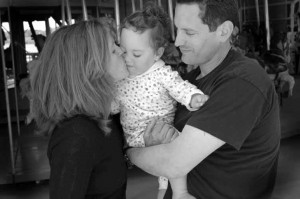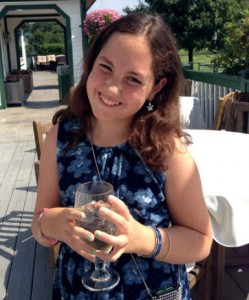
Imagine living every day of your life waiting for your child to have their next seizure. This is often the reality for parents of children with intractable epilepsy – a chronic form of epilepsy that can’t be controlled by medications alone. Every moment is plagued by uncertainty, and the world quickly becomes a place filled with barriers where hope and opportunity used to be.
This scenario is something with which James Marvin and his wife Joana are all too familiar. When their daughter, Charlotte, was diagnosed with epilepsy after having her first seizure at just 14 months old, this became their family’s world.
“We called it ‘the antagonist,’” said Marvin. “Charlotte would usually have a seizure every couple of days, but any time she was stressed, tired or sick, the antagonist would come out. It was so difficult to live our lives just waiting for the other shoe to drop, and there was no end in sight.”
That was, until five years later when they traveled 3,000 miles from their home in Virginia, to seek treatment at Seattle Children’s Hospital that held the promise of ending Charlotte’s seizures, hopefully for good.
Surgery as an option to stop the seizures
Epilepsy is the fourth most common neurological problem in the U.S., and it is estimated that more than 326,000 American children under the age of 15 have the disease.
“For two-thirds of these children, there are medication options for reducing, if not eliminating seizures,” said Dr. Jeffrey Ojemann, division chief of Neurosurgery, director of epilepsy surgery and co-director of the Epilepsy Program at Seattle Children’s. “Unfortunately, for kids like Charlotte, who fall into the final third, many live with chronic seizures because there are no medications that work for them, but for some, surgery can be an option.”
The surgery – which involves removal of the area of the brain from where the seizures are originating – is only considered after all other options have been exhausted, said Ojemann.
“In this stage, we come together in a multidisciplinary team, and we work to exhaust all of the alternative options,” said Ojemann. “We have to assess where the seizures are coming from, how certain we are about their origin, and what the potential consequences of removing that portion of the brain might be. It’s a balance, a calculated risk.”
The prospect of brain surgery would frighten even the most resolute parents, but the Marvins’ were thrilled that this could be the answer they’d been seeking for so many years.
“While Charlotte’s medications reduced the frequency of her seizures, they didn’t cure her and they also made it incredibly difficult for her to concentrate or do small, everyday tasks,” said Marvin, who was home from the Navy when Charlotte had her first seizure.
“As a parent, it was an impossible situation because part of us wanted to set rules for our daughter, but we also knew she was struggling each and every day,” said Marvin. “My wife and I spent all of our time trying to ease that burden, but we knew we could never do enough. If there was finally a chance that her doctors could help her, and allow her to have the life she deserved, we were going to pursue it.”
“She wasn’t behind her wall anymore.”
The Marvin family spent the next year consulting with the epilepsy care team at Seattle Children’s while they evaluated 8-year-old Charlotte as a candidate for surgery.

During this evaluation period, numerous procedures were performed to map the electrical activity in Charlotte’s brain to identify the area that was causing her seizures. This culminated in October 2011, when Charlotte had a diagnostic procedure called subdural grid placement surgery. Ojemann and his team placed small strips that contained electrodes over and around the areas of Charlotte’s brain that they suspected to be linked to her seizures. This allowed them to pinpoint the exact source: Charlotte’s left temporal lobe. The next step was the surgery to remove it, which took place in December 2011.
“From the moment Charlotte woke up after surgery, we knew immediately that it had been a success. She was different,” said Marvin. “For most of her life we felt like she was wrapped in cellophane, a degree removed from the world around her. For the first time, she was there. She wasn’t behind her wall anymore.”
While still on a few medications following the surgery, Charlotte was seizure-free for the first time, and she was doing better in school.
“It was like all of these doors were finally opening for her, and she was coming alive right before our eyes,” said Marvin.
Going home
After a year of Charlotte doing so well, the decision was made to gradually take her off of her medications – another tremendous milestone.
“After some time had gone by without any meds and no seizures, we had an appointment at Seattle Children’s, and they told us they didn’t need to see us anymore,” said Marvin. “Thinking about where we were when we first arrived, and how far we’d come, hearing that was surreal.”

Added Ojemann: “That’s the amazing thing about the work that we get to do – these surgeries can transform lives. I am lucky that each day I know I get the chance to do something that matters, and nothing is more rewarding than seeing tremendous outcomes in patients like Charlotte.”
After Charlotte’s surgery and successful weaning from the medication, the Marvin family moved to Boston, Mass. Charlotte is now 11-years-old, still seizure-free and is in every way on par with her peers. She skis, she camps; she gets to do all of the things a kid should do.
“We send a letter to the epilepsy care team every six months just to update them on Charlotte’s life and to say thank you,” said Marvin. “The entire team did so much for us, and most of it wasn’t about the medicine, they understood that how we felt was just as important. I want to make a million dollars someday so I can donate it to Seattle Children’s, and if I can’t do that, I’ll come out and sweep the sidewalks.”
Make a lasting difference in the lives of our patients and families. Donate today.
Resources:
- Epilepsy Program at Seattle Children’s
- What is Epilepsy?

